反身代词指示代词
- 格式:doc
- 大小:36.50 KB
- 文档页数:1
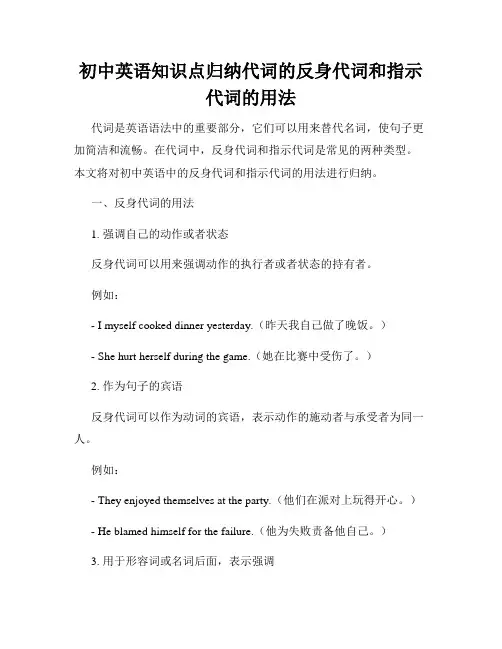
初中英语知识点归纳代词的反身代词和指示代词的用法代词是英语语法中的重要部分,它们可以用来替代名词,使句子更加简洁和流畅。
在代词中,反身代词和指示代词是常见的两种类型。
本文将对初中英语中的反身代词和指示代词的用法进行归纳。
一、反身代词的用法1. 强调自己的动作或者状态反身代词可以用来强调动作的执行者或者状态的持有者。
例如:- I myself cooked dinner yesterday.(昨天我自己做了晚饭。
)- She hurt herself during the game.(她在比赛中受伤了。
)2. 作为句子的宾语反身代词可以作为动词的宾语,表示动作的施动者与承受者为同一人。
例如:- They enjoyed themselves at the party.(他们在派对上玩得开心。
)- He blamed himself for the failure.(他为失败责备他自己。
)3. 用于形容词或名词后面,表示强调反身代词可以用于形容词或者名词后面,起强调作用。
例如:- The queen herself attended the event.(女王亲自参加了这个活动。
)- I myself am responsible for this project.(这个项目由我个人负责。
)二、指示代词的用法指示代词用来指示人或物,表明离说话者的距离或空间位置。
1. 指示远处的人或物例如:That is my pen.(那是我的钢笔。
)2. 指示近处的人或物例如:This is my book.(这是我的书。
)3. 指示两者中较远的人或物例如:Those are their bicycles.(那些是他们的自行车。
)4. 指示两者中较近的人或物例如:These are our chairs.(这些是我们的椅子。
)指示代词还可以作为主语、宾语或者定语使用,具体使用方式根据上下文的需要来决定。
三、反身代词和指示代词的辨析反身代词和指示代词虽然在形式上相似,但在用法上有所不同。
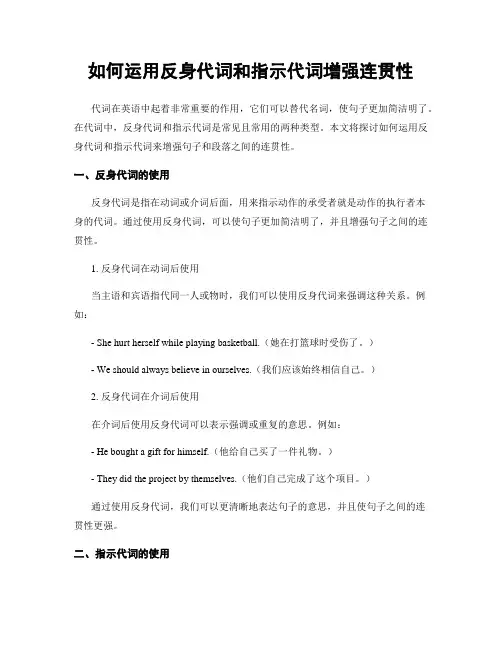
如何运用反身代词和指示代词增强连贯性代词在英语中起着非常重要的作用,它们可以替代名词,使句子更加简洁明了。
在代词中,反身代词和指示代词是常见且常用的两种类型。
本文将探讨如何运用反身代词和指示代词来增强句子和段落之间的连贯性。
一、反身代词的使用反身代词是指在动词或介词后面,用来指示动作的承受者就是动作的执行者本身的代词。
通过使用反身代词,可以使句子更加简洁明了,并且增强句子之间的连贯性。
1. 反身代词在动词后使用当主语和宾语指代同一人或物时,我们可以使用反身代词来强调这种关系。
例如:- She hurt herself while playing basketball.(她在打篮球时受伤了。
)- We should always believe in ourselves.(我们应该始终相信自己。
)2. 反身代词在介词后使用在介词后使用反身代词可以表示强调或重复的意思。
例如:- He bought a gift for himself.(他给自己买了一件礼物。
)- They did the project by themselves.(他们自己完成了这个项目。
)通过使用反身代词,我们可以更清晰地表达句子的意思,并且使句子之间的连贯性更强。
二、指示代词的使用指示代词用来指示特定的人或物,通过使用指示代词,可以使句子更加具体明了,并且增强句子之间的连贯性。
1. 指示代词作主语当我们需要强调特定的人或物是动作的执行者时,可以使用指示代词作为主语。
例如:- This is my book.(这是我的书。
)- That is your car.(那是你的车。
)2. 指示代词作宾语当我们需要强调特定的人或物是动作的承受者时,可以使用指示代词作为宾语。
例如:- I saw him yesterday. This made me very happy.(我昨天见到了他。
这让我很开心。
)- She gave me a present. That was very kind of her.(她给了我一个礼物。
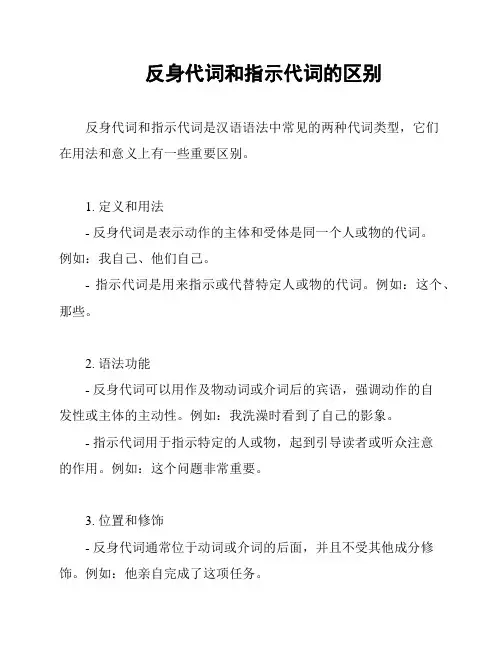
反身代词和指示代词的区别
反身代词和指示代词是汉语语法中常见的两种代词类型,它们
在用法和意义上有一些重要区别。
1. 定义和用法
- 反身代词是表示动作的主体和受体是同一个人或物的代词。
例如:我自己、他们自己。
- 指示代词是用来指示或代替特定人或物的代词。
例如:这个、那些。
2. 语法功能
- 反身代词可以用作及物动词或介词后的宾语,强调动作的自
发性或主体的主动性。
例如:我洗澡时看到了自己的影象。
- 指示代词用于指示特定的人或物,起到引导读者或听众注意
的作用。
例如:这个问题非常重要。
3. 位置和修饰
- 反身代词通常位于动词或介词的后面,并且不受其他成分修饰。
例如:他亲自完成了这项任务。
- 指示代词可以位于主语、宾语、定语、状语等位置,并且可以修饰其他成分。
例如:这个苹果很好吃。
4. 指示性质
- 反身代词是表示自己或某个群体成员之间的关系,具有反身性质。
- 指示代词是用来特定指代某个人或物,具有指示性质。
总结起来,反身代词强调主语与动作的关系,而指示代词主要用于指示和代替特定的人或物。
在句子中使用时,需要注意它们的不同用法和语法位置。
希望本文对你理解反身代词和指示代词的区别有所帮助。
![[荐]初中英语语法—人称代词、物主代词、反身代词、指示代词、疑问代词-全考点详解](https://uimg.taocdn.com/c671bde7bed5b9f3f80f1c57.webp)
初中英语语法—人称代词、物主代词、反身代词、指示代词、疑问代词-全考点详解一、人称代词1.人称代词指代人或物,分为主格和宾格。
主格在句中充当主语;宾格在句中充当动词的宾语或表语、介词的宾语。
2.人称代词的顺序当多个人称代词并用时,单数你他我,复数一二三,道歉我为先。
如:You, he and I are 18./ We, you and they are from China.3.it的用法(1)it除了用来代替上文所提到的事物外,还可用来表示时间、天气、距离、季节等。
如:-How's the weather today?-It's sunny.(2)可代替动词不定式作句中的形式主语或形式宾语。
It's + adj./n. (for sb./ of sb.) + to do sth. (it作形式主语);sb. find(s)/think(s) it + adj.+ to do sth. (it作形式宾语)。
如:It's necessary for us to learn English well.She found it difficult to learn geography.二、物主代词物主代词分为形容词性物主代词和名词性物主代词。
1.形容词性物主代词作定语修饰名词,不能单独使用。
如:This is her dictionary.2.名词性物主代词相当于"形容词性物主代词+名词",句中作主语、宾语、表语,可与of所有格连用。
如:This dictionary is hers./She is a friend of mine.三、反身代词反身代词表示"某人自己的"。
句中可用作动词或介词的宾语,也可用作主语或宾语的同位语,表示强调。
反身代词的构成规律是:第一、二人称的反身代词是形容词性物主代词+self/selves;第三人称的反身代词是人称代词宾格+self/selves。
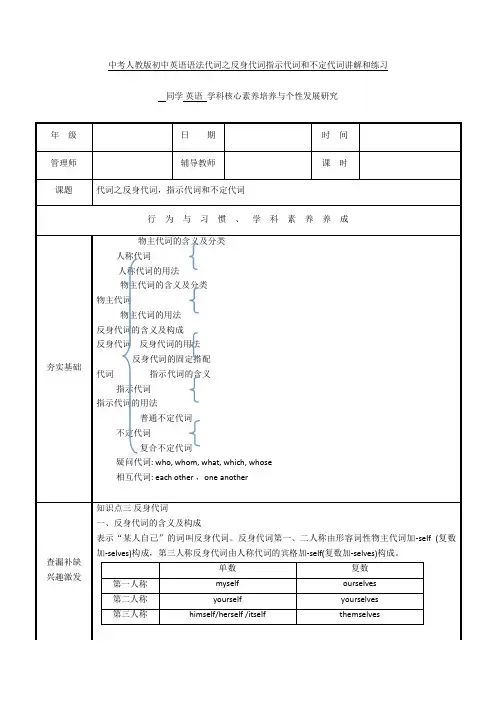
中考人教版初中英语语法代词之反身代词指示代词和不定代词讲解和练习同学英语学科核心素养培养与个性发展研究1.There are several pretty girls standing under the tree, but ______ are known to me.a. neitherb. nonec. no oned. all2.In one year rats eat 40 to 50 times ______ weight.a. itsb. andc. theird. theirs3.You’d better continue to use the same spelling of your name as ____ you used in your application.a. oneb. the onec. anyd. some one4.The little baby was left alone, with ______ to look after it.a. someoneb. anyonec. not oned. no one5.John can play chess better than ______ else.a. the oneb. no onec. any oned. another6.The weight of something is another way of describing the amount of force exerted on __ by gravity.a. itb. themc. thatd. one7.It is one thing to enjoy listening to good music, but it is quite ______ to perform skillfully yourself.a. otherb. anotherc. somed. any8.Children should be taught how to get along with ______.a. anotherb. otherc. othersd. any other9.The poor man lived on wild berries and roots because they had ______ to eat.a. nothing elseb. anything elsec. something otherd. nothing other10.I go to the cinema ______ day, Tuesdays, Thursdays, and Saturdays.a. each otherb. every otherc. this and the otherd. all other11.One of the properties of light is _____ traveling in wave form as it goes from one place to another.a. itb. it’sc. itsd. their12.______ in the world has been asked to do his duty for the human society.a. Each of the trampsb. Every of the trampsc. The each trampd. The every tramp13.In some restaurants, food and service are worse than ______ used to be.a. theyb. itc. themd. that14.Let the porter take all the baggage out and put ______ in the lobby.a. itb. theyc. themd. its15.Everyone who comes to the party is given a wooden apple with _____ own names cut in it as a souvenir.a. hisb. herc. theird. our16.Everybody in the class must give in ______ exercise book within the given time.a. theirb. ourc. hisd. her17.During the journey, the boys and girls entertained ______ with songs and games.a. themselvesb. theirselvesc. himselfd. itself18.You’d better buy ______ some fruits when you go on a trip.a. youselfb. myselfc. yourselfd. you19.The boys in this town like to bully ______.a. one anotherb. one and otherc. each otherd. one and the other20.One common family name is Black,______ is Anderson.a. anotherb. the otherc. othersd. none other21.I have two novels: one of the two is “Gone with the Wind’, and ______ is “the Tale of Two Cities’.a. anotherb. otherc. none otherd. the other22.All girls wear beautiful clothes. Some are dressed in red;______ in green.a. otherb. anotherc. othersd. none other23.She can’t seem to help herself. And ______ c an help her, either.a. none elseb. no one elsec. not anyd. somebody else24.Children can usually dress ______ by the age of five.a. himb. themc. hiselfd. themselves25.The gold watch had belonged to me for years, but the police refused to believe it was ______.a. meb. myc. mined. I’s26.Mother would not let Mary and ______ attend the hockey game.a. Ib. myc. med. we27.In a news conference this afternoon, the university announced that ______ intends to make sev eral important changes in next year’s budget.a. heb. itc. shed. they28.______ but a fool can make such a mistake.a. Everyoneb. No otherc. Not alld. None29.The poem by Browning is so observed that I cannot grasp ______ meaning.a. itsb. it’sc. theird. that30.The mayor felt that the police, in spite of the reports, had done ______ best.a. itsb. theirc. hisd. our31.I haven’t read ______ of the last four chapters, so I know little about them.a. anythingb. anyc. somed. something32.A pretty face may win friends but it takes character and personality to hold ______.a. itb. themc. thatd. one33.In the discussion, one speaker held that, since we live in a money-oriented society, the average individual cares little about solving ______.a. anyone else’s problemsb. anyone’s else problemsc. anyone else problemsd. problems of anyone else34.I don’t know whether small oranges are sweeter than big ______.a. thoseb. onesc. oned. that35.‘How much water is left in the bottle?’ ‘______’a. Nothingb. Nonec. Not somed. Not one36.It took two of them to do the work that ______ of us could do.a. someoneb. anyonec. any oned. everyone37.He has five children, and ______ of them is good at painting.a. everyoneb. everybody d. every one d. every38.I have three brothers,______ are in Beijing.a. no one of themb. neither of themc. some of themd. none of them39.Some of my students study a lot,______ just don’t care.a. anothersb. the otherc. some otherd. others40.As a matter of fact, Saudi Arabia’s oil reserves are second only to ______.a. Kuweitb. that of Kuweitc. Kuweits’sd. those of Kuweit41.This book of _______ used to be one of the best sellers in the shop.a. hisb. himc. that mand. this42.We should always keep ______ well-informed of the changing information.a. usb. oursc. ourselvesd. we二、英语书面表达专项训练2.假如你是李华,你的英国笔友 Jack 给你写邮件表达了想参加你校暑期为外国学生举办的汉语夏令营的愿望,希望你告知活动举办的具体时间地点,活动安排以及你的建议。
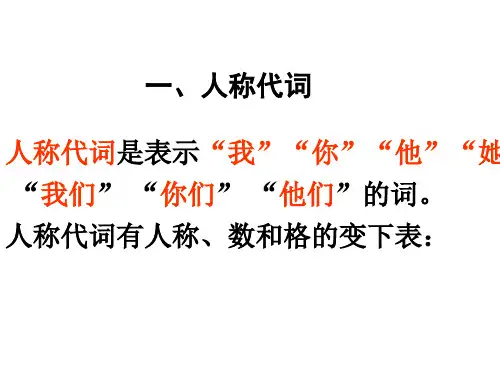
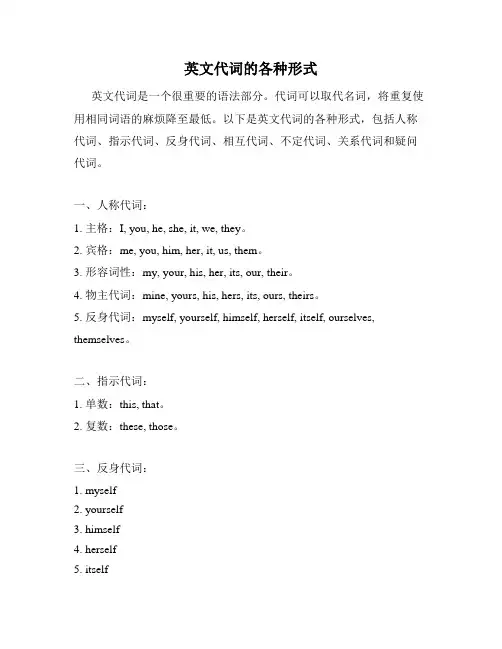
英文代词的各种形式英文代词是一个很重要的语法部分。
代词可以取代名词,将重复使用相同词语的麻烦降至最低。
以下是英文代词的各种形式,包括人称代词、指示代词、反身代词、相互代词、不定代词、关系代词和疑问代词。
一、人称代词:1. 主格:I, you, he, she, it, we, they。
2. 宾格:me, you, him, her, it, us, them。
3. 形容词性:my, your, his, her, its, our, their。
4. 物主代词:mine, yours, his, hers, its, ours, theirs。
5. 反身代词:myself, yourself, himself, herself, itself, ourselves, themselves。
二、指示代词:1. 单数:this, that。
2. 复数:these, those。
三、反身代词:1. myself2. yourself3. himself4. herself5. itself6. ourselves7. yourselves8. themselves四、相互代词:1. each other2. one another五、不定代词:1. some2. any3. no4. anybody/anyone5. somebody/someone6. nobody/no one7. everybody/everyone六、关系代词:1. that2. which3. who4. whom5. whose七、疑问代词:1. what2. who3. whom4. which5. whose以上是英文代词的各种形式。
对于想要成功学习英文的人来说,掌握这些代词是必不可少的。
对于英文写作、口语和听力理解来说,代词是非常重要的。
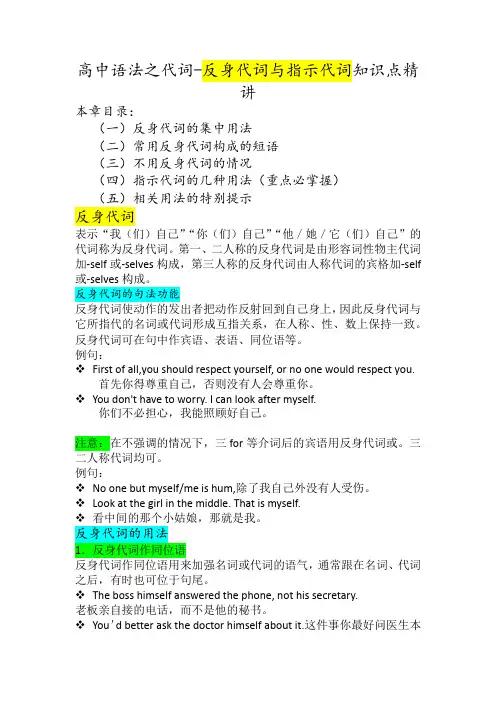
高中语法之代词-反身代词与指示代词知识点精讲本章目录:(一)反身代词的集中用法(二)常用反身代词构成的短语(三)不用反身代词的情况(四)指示代词的几种用法(重点必掌握)(五)相关用法的特别提示反身代词表示“我(们)自己”“你(们)自己”“他/她/它(们)自己”的代词称为反身代词。
第一、二人称的反身代词是由形容词性物主代词加-self或-selves构成,第三人称的反身代词由人称代词的宾格加-self 或-selves构成。
反身代词的句法功能反身代词使动作的发出者把动作反射回到自己身上,因此反身代词与它所指代的名词或代词形成互指关系,在人称、性、数上保持一致。
反身代词可在句中作宾语、表语、同位语等。
例句:❖First of all,you should respect yourself, or no one would respect you.首先你得尊重自己,否则没有人会尊重你。
❖You don't have to worry. I can look after myself.你们不必担心,我能照顾好自己。
注意:在不强调的情况下,三for等介词后的宾语用反身代词或。
三二人称代词均可。
例句:❖No one but myself/me is hum,除了我自己外没有人受伤。
❖Look at the girl in the middle. That is myself.❖看中间的那个小姑娘,那就是我。
反身代词的用法1.反身代词作同位语反身代词作同位语用来加强名词或代词的语气,通常跟在名词、代词之后,有时也可位于句尾。
❖The boss himself answered the phone, not his secretary.老板亲自接的电话,而不是他的秘书。
❖You'd better ask the doctor himself about it.这件事你最好问医生本人。
❖I cooked it myself.(=I myself cooked it.)我自己做的饭。
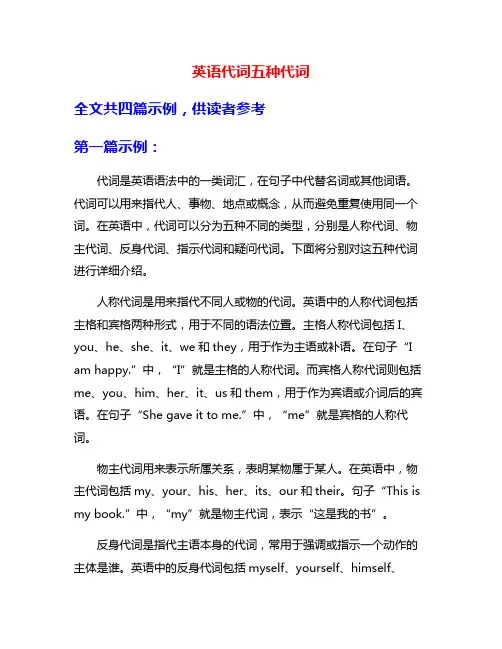
英语代词五种代词全文共四篇示例,供读者参考第一篇示例:代词是英语语法中的一类词汇,在句子中代替名词或其他词语。
代词可以用来指代人、事物、地点或概念,从而避免重复使用同一个词。
在英语中,代词可以分为五种不同的类型,分别是人称代词、物主代词、反身代词、指示代词和疑问代词。
下面将分别对这五种代词进行详细介绍。
人称代词是用来指代不同人或物的代词。
英语中的人称代词包括主格和宾格两种形式,用于不同的语法位置。
主格人称代词包括I、you、he、she、it、we和they,用于作为主语或补语。
在句子“I am happy.”中,“I”就是主格的人称代词。
而宾格人称代词则包括me、you、him、her、it、us和them,用于作为宾语或介词后的宾语。
在句子“She gave it to me.”中,“me”就是宾格的人称代词。
物主代词用来表示所属关系,表明某物属于某人。
在英语中,物主代词包括my、your、his、her、its、our和their。
句子“This is my book.”中,“my”就是物主代词,表示“这是我的书”。
反身代词是指代主语本身的代词,常用于强调或指示一个动作的主体是谁。
英语中的反身代词包括myself、yourself、himself、herself、itself、ourselves和themselves。
在句子“He hurt himself.”中,“himself”表示“他自己”。
指示代词用来指示或代替特定的人或物,帮助读者或听者更好地理解上下文。
英语中的指示代词包括this、that、these和those。
在句子“This is a pen.”中,“this”指代离说话者较近的物体。
疑问代词用来引导疑问句,提出问题或在句子中做主语或宾语。
英语中的疑问代词包括who、whom、whose、which和what。
在句子“Who is she?”中,“who”用来引导疑问句,询问某人的身份。

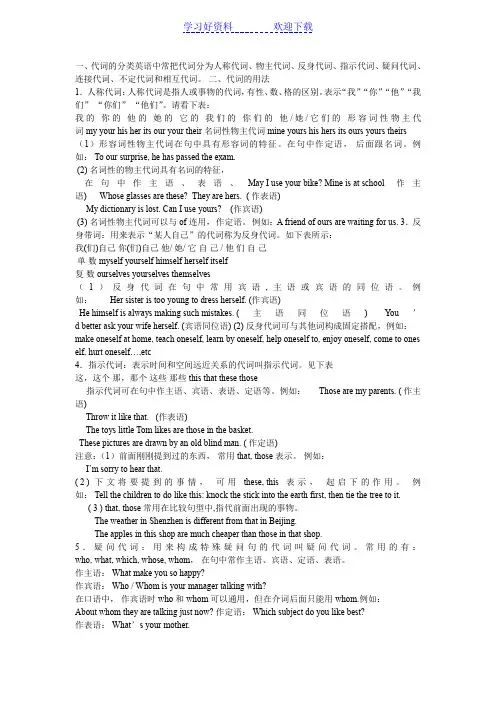
一、代词的分类英语中常把代词分为人称代词、物主代词、反身代词、指示代词、疑问代词、连接代词、不定代词和相互代词。
二、代词的用法1.人称代词:人称代词是指人或事物的代词,有性、数、格的区别。
表示“我”“你”“他”“我们”“你们”“他们”。
请看下表:我的你的他的她的它的我们的你们的他/她/它们的形容词性物主代词 my your his her its our your their 名词性物主代词 mine yours his hers its ours yours theirs (1)形容词性物主代词在句中具有形容词的特征。
在句中作定语,后面跟名词。
例如: To our surprise, he has passed the exam.(2) 名词性的物主代词具有名词的特征,在句中作主语、表语、 May I use your bike? Mine is at school作主语) Whose glasses are these? They are hers. ( 作表语)My dictionary is lost. Can I use yours? (作宾语)(3) 名词性物主代词可以与of 连用,作定语。
例如:A friend of ours are waiting for us. 3.反身带词:用来表示“某人自己”的代词称为反身代词。
如下表所示:我(们)自己你(们)自己他/ 她/ 它自己 / 他们自己单数 myself yourself himself herself itself复数 ourselves yourselves themselves(1)反身代词在句中常用宾语,主语或宾语的同位语。
例如: Her sister is too young to dress herself. (作宾语)He himself is always making such mistakes. (主语同位语) You’d better ask your wife herself. (宾语同位语) (2) 反身代词可与其他词构成固定搭配,例如:make oneself at home, teach oneself, learn by oneself, help oneself to, enjoy oneself, come to ones elf, hurt oneself…,etc4.指示代词:表示时间和空间远近关系的代词叫指示代词。
代词代词主要有以下几类:人称代词、物主代词、反身代词、指示代词、疑问代词、不定代词、相互代词。
一、人称代词人称代词:表示或事物,它有人称、数、格的变化。
单数复数主格I you He she it we they you宾格me you Him her it us them you 一般说来,主格用作主语,宾格用作宾语。
如:He told me that he had been to Beijing before:Ask her to come early.注:1、当第一人称与第二,三人称代词并列时,通常的语序是:第二,三人称代词在前,第一人称代词在后,即:“你,他,我”的顺序,例如:Y ou and I can do it .They know neither you nor them nor me .2、当人称代词宾格在动副形短语中,应置于动词后,副词前,如:Pick it up, Put them on.二、物主代词物主代词:表示所有关系的代词称为物主代词,也即人称代词属格,它分为名词性物主代词和形容性物主代词。
形容词性my your his her its our your Their名词性mine yours his hers its ours yours theirs 名词性物主代词可以独立充当句子成分,起名词词组的作用。
它主要充当句子的主语、表语、宾语、介宾。
This car is his(表语)His brother is a driver, mine is a soldier and hers is an engineer. (主语) (mine=my brother, hers=her brother)I’ll do my work and you will do yours (宾语)yours =your workMary’s car is just like yours(介宾)注:“of +名词性物主代词”可作定语,如Tom is a friend of mine.This baby of hers is s她这个孩子真可爱!形容词性物主代词在句中用作定语,另外,它可以与ow n 连用。
代词是代替名词的词类.大多数代词具有名词和形容词的功能。
英语中的代词,按其意义、特征及在句中的作用分为:人称代词、物主代词、指示代词、反身代词、疑问代词、不定代词。
一.人称代词:代替具体人名的词叫人称代词。
它有一、二、三人称与单数、复数及性别之分,还有主格与宾格之分。
人称代词有人称、数和格的变化:(1)Who’s Kate? 凯特是谁?She’s my friend。
她是我的朋友。
注:she代替上文中的Kate,而不能再用Kate来重复回答:Kate is my friend.(2)Li Lei is a boy. He's twelve。
李雷是个男孩,他十二岁。
注:he代替前句中的李雷。
(3)Look at that bird. It is Polly. 看那只鸟,它是波利。
注:it代替前句中的that bird。
(4)Who’s it?(门外有敲门声)谁呀? It's me。
是我.人称代词的用法★1)人称代词的主格在句子中作主语。
例如:He is student. 他是一个学生。
★2)人称代词的宾格在句子中作宾语或介词宾语,但在口语中也能作主语补语.)例如:I saw her with them at least,I thought it was her。
我看到她和他们在一起,至少我认为是她。
(her做宾语,them做介词宾语,her做主语补语)—— Who broke the vase?—-谁打碎了花瓶?—— Me. -—我.(me做主语补语= It's me。
)难点:主格和宾格的区别用法主格做句子主语,而宾格作为动词或者介词的宾语.(动宾结构或者介宾结构)例如:Give it to me。
(宾格)I love you. (主格)3). 并列人称代词的排列顺序①单数人称代词并列作主语时,其顺序为:第二人称-> 第三人称-> 第一人称,即you-> he/she; it -> I。
英语代词分类一.英语代词1、代词的分类:英语中代词分为:人称代词、物主代词、反身代词、指示代词、关系代词、疑问代词、连接代词和不定代词等等。
2、人称代词:人称代词代替人和事物的名称,分为主格和宾格两种形1Sundays.(星期天我常去购物) / Are from Brazil?(他们是巴西人吗?) / Where gone?(他们上哪儿去了?) / That’s 就那么回事) / It’s (是他!)2、宾格用来作及物动词或者介词的宾语。
如:Who teaches English this year?(今年谁教你们的英语?) / Help (救救我!) / We often write letters to (我们常给他写信)3、人称代词作表语或者放在比较状语从句连词than或as 之后时,可以用主格形式,也可以用宾格形式,口语中大多用宾格。
如:--Who is it?(是谁?) CIt’s (是我。
)4、三个不同人称同时出现,或者主语中包含“我”时,按照“you→he→I”的顺序表达。
如:.(我和他都在那家电脑公司上班) CWho will go there?(谁要去那儿?) C.(你和我)5、人称代词it除了可以指人指物之外,还可以表示“时间、天气、温度、距离、情况”等含义,此外还可以作“非人称代词”使用,替代作主语或者宾语的不定式、动名词或者名词性从句。
如:--What’s the weather like today?(今天天气怎样?)―It’s fine.(天气晴好) / --What’s the time?(几点啦?) C:00.(12点) / It’s a long way to go.(那可要走好长的路) / It took him (打扫屋子花了他三天的时间)(很显然,公众想知道这些人什么时候能进入太空) .(我们发觉要学好一门外语是非常困难的)3词。
如:(那是你的伞吗?)aunt on Sundays.(我经常在星期天去看望阿姨)books.(是他们的书)2、名词性物主代词相当于名词,既代替事物又表明所属关系,在句子中往往独立地作主语、宾语或者表语,后面千万不可以跟名词。
反身代词反身代词又称为自身代词,表示动作行为反射到行为执行者本身。
它还可以在句中起到强调的作用,用以加强语气。
英语中共有八个反身代词,在使用时应注意和它所指的相应的对象在人称、性别、数上保持一致。
其基本形式如下表所示:数人称第一人称第二人称第三人称单数myself yourself himself herself itself复数ourselves yourselves themselves用法:1 可用作宾语,指的是宾语和主语表示同一个或同一些的人或事物。
如:Maria bought herself a scarf. 玛丽亚给自己买了一条围巾。
We must look after ourselves very well. 我们必须好好照顾自己。
2 可用作表语,指的是表语和主语表示同一个或同一些人或事物。
如:She isn’t quite herself today. 她今天有点不舒服。
3 可用作主语或宾语的同位语,常用来加强语气。
如:She herself will fly to London tomorrow. 明天她自己将要坐飞机去伦敦。
I met the writer himself last week. 我上周见到了那位作家本人。
4 用在某些固定短语当中。
look after oneself / take care of oneself 照顾自己teach oneself sth./ learn sth. by oneself自学enjoy oneself玩得高兴,过得愉快help oneself to sth请自用……(随便吃/喝些……).hurt oneself摔伤自己 say to oneself自言自语lose oneself in 沉浸于,陶醉于……之中leave sb. by oneself把某人单独留下buy oneself sth.给自己买……东西introduce oneself 介绍……自己“介词+反身代词”的固定词组有:①by oneself (=alone):独自地;单独地She lives by herself. 她一个人住着。
人称代词、物主代词、反身代词、指示代词用法归纳及练习人称代词、物主代词、反身代词、指示代词用法归纳代词的分类:代词可分为八类:1) 人称代词2) 物主代词3) 反身代词4) 指示代词5) 疑问代词6) 连接代词 7) 关系代词 8) 不定代词代词的用法:1.人称代词:表示' 我, 我们,你, 你们,他, ,他们等' 的词叫做人称代词。
人称代词有人称,数和格之分。
主格宾格主格宾格第一人称I me we us第二人称 you you you you第三人称 he,she,it him,her,it they them人称代词可用作主语,表语,宾语以及介词的宾语。
(主格做主语,宾格做动词或介词的宾语)I am a worker, I work in the factory. 我是一个工人,我在工厂工作(I做主语)。
You are a good teacher. 你是一位优秀教师。
(You做主语)She is a little girl. 她是一个小女孩。
(she做主语)It's a heavy box, I can't carry it. 这是一个重盒子,我搬不动。
(It 做carry的宾语)It's me. Open the door quickly.是我, 快开门。
Don't tell him about it. 不要告诉他这件事情。
(It做介词about 的宾语)She is always ready to help us. 她随时都在准备帮助我们。
(she 做主语,us做help的宾语)Our teacher is very strict with us. 我们的老师对我们很严格。
(us做介词with的宾语)人称代词中几个注意的情况:(1)第一人称单数代词 ' I (我)' 不论在什么地方都要大写。
I study English every day. 我天天学习英语。
代词高考对代词的考查主要是人称代词、物主代词、反身代词、指示代词、不定代词、疑问代词和关系代词等;设置特定的语境,对代词的数、性、格的变化进行考查仍然是高考的热点;Ⅰ代词的分类1.人称代词:主格I, we, you, he, she, it, they宾格me, us, you, him, her, it, them2.物主代词:形容词性my, our, your, his, her, its, their名词性mine, ours, yours, his, hers, its, theirs3.反身代词:单数myself, yourself, himself, herself, itself复数ourselves, yourselves, themselves4.相互代词:each other 两者之间相互;one another 两者以上的相互5.指示代词:this, that, these, those6.疑问代词:who, whom, whose, which, what7.关系代词:who, whom, whose, that指人,which, that, as, whose 指物8.不定代词:all, each, either, neither, both, none, other, another, something, everything, nothing somebody, everybody, nobody someone, everyone, no one, many, much, few, less一、人称代词单数复数第一人称第二人称第三人称第一人称第二人称第三人称人主I you he,she,itwe you they称代词格宾格me you him,her,itus you them人称代词的用法1.人称代词的主格在句子中作主语或主语补足语;如:John waited a while but eventually he went home.约翰等了一会儿,最后他回家了; John hoped the passenger would be Mary and indeed it was she.说明:在复合句中,如果主句和从句主语相同,代词主语要用在从句中,名词主语用在主句中;When he arrived,John went straight to the bank.约翰一到就直接去银行了;2.人称代词的宾格在句子中作宾语或介词宾语,但在口语中也能作主语补语,第一人称在省略句中,还可以作主语;如:I saw her with them;at least,I thought it was her.第一个her作动词宾语,them作介词宾语,第二个her作表语—Who broke the vase谁打碎了花瓶—Me.我;3.人称代词之主、宾格的替换1宾格代替主格在简短对话中,当人称代词单独使用或在not 后,多用宾语;—I like English.;—Me too.—Have more wine—Not me.;在表示比较的非正式的文体中,常用宾格代替主格; 但如果比较状语的谓语保留,则主语只能用主格;He is taller than I/me. He is taller than I am.2主格代替宾格在介词but,except后,有时可用主格代替宾格;在电话用语中常用主格;—I wish to speak to Mary.;—This is she.注意:在动词be 或to be后的人称代词视其前面的名词或代词而定;I thought it was she.我以为是她;主格——主格I thought it to be her.宾格——宾格I was taken to be she.我被当成了她;主格——主格They took me to be her.他们把我当成了她;宾格——宾格4.代词的指代问题1不定代词anybody,everybody,nobody,anyone, someone, everyone,no one, 及whoever和person在正式场合使用时,可用he,his,him代替;如:Nobody came,did he2动物名词的指代一般用it或they代替,有时也用he,she,带有亲切的感情色彩;如:Give the cat some is hungry.;3指代车或国家,船舶的名词,含感情色彩时常用she;5.并列人称代词的排列顺序1单数人称代词并列作主语时,其顺序为:第二人称→ 第三人称→第一人称,即you→ he/she; it → I;如:You,he and I should return on time.你,他还有我应该按时回来;2复数人称代词作主语时,其顺序为:第一人称→ 第二人称→第三人称,即we→you→they;在下列情况中,第一人称放在前面;在承认错误,承担责任时;It was I and John that made her angry.是我和约翰惹她生气了;在长辈对晚辈,长官对下属说话时,如长官为第一人称,如:I and you try to finish it.并列主语只有第一人称和第三人称时;当其他人称代词或名词被定语从句修饰时;二、物主代词物主代词是表示所有关系的代词,也可叫做代词所有格;物主代词分形容性物主代词和名词性物主代词两种,其人称和数的变化见下表;单数复数第一人称第二人称第三人称第一人称第二人称第三人称物主代词形容词性my your his,her,its our your their名词性mine your shis,hers,its ours yours theirsOur school is here,and theirs is there.我们的学校在这儿,他们的在那儿;1.物主代词的用法1物主代词既有表示所属的作用又有指代作用;如:John had cut his finger; apparently there was a broken glass on his desk.2物主代词有形容词性my,your等和名词性mine,yours等两种,形容词性的物主代词属于限定词;名词性的物主代词在用法上相当于省略了中心名词的’s属格结构;如:Jack’s cap意为The cap is Jack’s;His cap意为The cap is his;2.名词性物主代词的句法功能1作主语;如:May I use your pen Yours works better.2作宾语;如:I love my motherland as much as you love yours.3作介词宾语;如:You should interpret what I said in my sense of the word,not inyours.4作表语;如:The life I have is ’s ’s yours.3.双重所有格物主代词不可与a,an,this,that,these,those,some,any,several,no,each,every,such,another,which等词一起前置,修饰一个名词,而必须用双重所有格;公式为:a,an,this,that+名词+of+名词性物主代词;三、指示代词指示代词表示“那个”“这个”“这些”“那些”等指示概念的代词;指示代词有this,that,these,those等;如:That is a good idea.指示代词的用法1.指示代词分单数this/that和复数these/those两种形式,既可作限定词又可作代词;2.指示代词的句法功能;1作主语;如:This is the way to do it.2作宾语;如:I like this better than that.3作表语;如:My point is this.4作介词宾语;如:I don’t say no to that.There is no fear of that.说明1:指示代词在作主语时可指物也可指人,但作其他句子成分时只能指物,不能指人;如:对That is my teacher.那是我的老师;that作主语,指人对He is going to marry this girl.他要和这个姑娘结婚;this作限定词错He is going to marry this.this作宾语时不能指人对I bought this.我买这个;this指物,可作宾语说明2:that和those可作定语从句的先行词,但this和these不能,同时,在作先行词时,只有those可指人,试比较:对He admired that which looked beautiful.对He admired those who looked beautiful.他赞赏那些外表漂亮的人;those 指人错He admired that who danced well.that 作宾语时不能指人对He admired those who danced well.他赞赏跳舞好的人;those 指人对He admired those which looked beautiful.他赞赏那些外表漂亮的东西;those指物四、反身代词表示“我自己”“你自己”“他自己”“我们自己”“你们自己”和“他们自己”等的代词,叫做自身代词,也称为“反身代词”;如:She was talking to herself.她自言自语;反身代词单数复数第一人称第二人称第三人称第一人称第二人称第三人称myself yourself himselfherselfitselfourselves yourselves themselves反身代词的用法1.作宾语,如1有些动词需有反身代词,如absent,bathe,amuse,blame,dry,cut,enjoy,hurt,introduce,behave等;如:We enjoyed ourselves very much last night.Please help yourself to some fish.2用于及物动词+宾语+介词,如:take pride in,be annoyed with,help oneself to sth 等;I could not dressmyselfup at that time.注:有些动词后不跟反身代词,如:get up,stand up,wake up等;Please sit down.2.用作表语;如;I am not myself today.3.用作同位语;如The thing itself is not important.4.在不强调的情况下,but,except,for 等介词后宾语用反身代词或人称代词宾格均可;注意:1反身代词本身不能单独作主语;错Myself drove the car.对I myself drove the car.我自己开车;2但在and,or,nor连接的并列主语中,第二个主语可用反身代词,特别是myself 作主语;Charles and myself saw it.查尔斯和我看见了这件事;五、相互代词表示相互关系的代词叫相互代词,有each other和one another两个词组;他们表示句中动词所叙述的动作或感觉在涉及的各个对象之间是相互存在的;如:It is easy to see that the people of different cultures have always copied each other.,相互借鉴的相互代词宾格each other,one another所有格each other’s,one another’s相互代词的句法功能1.作动词宾语;如:People should love one another.人们应当彼此相爱;2.可作介词宾语;Dogs bark,cocks crow,frogs croak to each other.犬吠、鸡鸣、蛙儿对唱;说明:传统语法认为,相互关系存在于两个人或物之间用each other, 存在于两个以上人和物之间用one another;现代英语中,两组词交替使用的实例也很多;He put all the books beside each other/one another.他把所有书并列摆放起来; Usually these small groups were independent of each other.这些小团体通常是相互独立的;3.相互代词可加’s构成所有格;如:The students borrowed each other’s notes.六、不定代词不是指明代替任何特定名词的代词叫做不定代词;常见的不定代词有all,both,each,every等,以及含有some,any,no等的合成代词,如anybody,something,no one;这些不定代词大都可以代替名词和形容词,在句中作主语、宾语、表语和定语,但none和由some,any,no等构成的复合不定代词只能作主语、宾语或表语;every 和no只能作定语;如:—Do you have a car— Yes,I have one.—I don’t know any of them.他们,Ⅱ代词的用法1. nothing, none, no onenone作为代词,最常用来表示数量,它可以是一个可数的概念how many也可以是一个不可数的概念how much,或者any引起的问题;而nothing是相对于something有某物什么都没有,它回答的是“What is in/on...”的问题;而no one=nobody没有人,它回答的是“Who did that”谁……或是anyone有没有人的问题;2. one, ones, that, those, it1one和ones可以用来代替前面提到过的可数名词,one代单数,ones代复数,其中:两者都可以指代物只要是可数one前面一般不加a,因为它本身有“一个”的意思,但如果one前面有形容词修饰,则需要加a/an;one可以单独使用,意思为“任何人”;例如:—Shall we have a rest—Didn’t we just have one因为one=a somethingOne should always believe in oneself.2that与those:that可以代替前面提到的不可数名词或可数名词单数相当于the one;而those 代替前面提到的复数名词,有时可以用the ones替换;例如:The population of China is bigger than that of India. that=the populationThe boy told his story and that of the girl next room.that=the storyThe cell phones we made nowadays are better than those/the ones made 2 years ago.those=the cell phones=the ones3one和it:两者都可以用来代替前面出现过的单数名词,one指这类东西中的任何一个,指类属,泛指;it指前面所指的同一物;例如:I need a pen to sign my name. Can I have one one =a pen I cannot find my new pen. Have you seen itit指那支新钢笔3. another, the other, other, others, the others1another和the other:两者都是“另一个”的意思,但数量上有区别:用another指两个以上的数量,而the other只指两个中的另一个,例如:He has three brothers, one is a teacher, another is a doctor and the third is an engineer.注:another除了可以作代词,还可以用作形容词;这里有必要区别another, the other和more的用法:①another:another表“另一个”时只跟可数名词单数,而表“另外的、额外的、附加的”时,可跟带有few或具体数字的复数名词,此时可把“数词+复数名词”看作是一个整体;例如:—Have you finished your report yet—No,I will finish it in another 10 minutes.There is room for another few people in the back of the bus.②other:表“另外的”接复数名词,如与具体数词连用,则置于数词之后,但与定冠词the连用时,other要放在数词前;例如:Tony is going camping with two other little boys next Sunday.Do you know where he found the other two photos③more:more一般位于数词之后,名词之前,有时也可置于名词之后;例如:One more stepOne step more,and I’ll shoot you.Where shall we be in ten more yearsmore除跟数词外,还可与many, a little,a few,a lot,several等词连用,例如:There are many more dictionaries on the desk.Would you like some more tea2 others, the othersothers是相对于some来说的:some...some....others... 一些……一些……另一些……是泛指;而the others是特指另一些,相对于ones 可以理解为one, the other 的复数;例如:Class 1 are cleaning the classroom. Some are sweeping the floor, some are cleaning the window, and others are washing the blackboard. 泛指There are only 20 students in the classroom, where are the others.特指4. both, other, neither, each, any, allboth:两者都,谓语动词用复数;either:两者中间的任何一个,谓语动词用单数;neither:两者中间无任何一个,谓语动词多用单数,也可以用复数;each:两个或两个以上中的每一个,谓语动词用单数;any:三者或三者以上中的任何一个,谓语动词用单数;all:三者或三者以上全部;5. some, any, nosome属于肯定词,主要用于肯定句中,但当说话人期待肯定回答时,也可以用于疑问句中;例如:Could I have some more tea, please Would you like some more coffeeany属于非肯定词,主要用于否定句、疑问句或条件句中;它可以与形容词的比较级连用;例如:Don’t come any closer,or I’ll shootno属于否定词,用于否定句中:no+可数名词单数=not a/an no+可数名词复数=not any;例如:There is no such thing as a free lunch in the world.考点诠释纵观历年高考试题,代词的主要考点主要集中在以下几个方面:不定代词one,the one,ones,the ones;物主代词的用法;人称代词主格和宾格的用法;表示两者和多者的不定代词的比较;指示代词this,that,these,those,it的用法;another,theothers,else;the rest的用法;every-,some-,any-,no-与-thing,-one,-body构成的复合不定代词的用法;考点1 人称代词一般地说人称代词作主语时用主格;作宾语时用宾格;作定语时用形容词性物主代词;名词性物主代词可以代替“形容词性物主代词+名词”;但口语中,在无动词的句子里,往往用代词的宾格形式;1.用于无谓语的句子中一Dpes any of you know why Jack hasn’t come yet一Me.;答语如果带谓语,就得用主格,如:I can.和I do,too./So do I.2.表示惊奇、猜疑、反问、不满、厌烦等①Do you have good eyesight,young man一MeI can see a sparrow two hundred paces away.②WhatMe fight a big chap like himNot me3.代替as,than等连词之后的主格多用于口语中,尤其用于句末①I’m not as tall as himhe.;②She is much more careful than meI.她比我细心得多;当这类人称代词带有all,both等同位语时,用宾格的形式就更为常见了;如:He works harder than us a11.典例:Our neighbers gave a baby bird yesterday that hurt when it fell from its nest. A.us;it B.us;itself C.ourselves;itself D.ourselves;it考点2指不代词1.this/these,that/thosethis,these指代下面要说的内容;that,those指代上面陈述过的内容;如:①What I’d like to say about how to improve our spoken English is like this.②That’s a11.Thank you.③Salaries are higher here than those inmy hometown.2.一些习惯说法中this和that的用法比较固定①Who’s that你是谁②This is Mary.③11at’s all right/OK.;对感谢的答语④nat’S nothing.;对道歉的答语‘⑤That’s that.表示决定不能更改⑥That’S a11.就这些了;⑦That is…那就是……3.this,that有时可以用作副词,意为“这么,那么”,用在形容词或副词前作状语,表示程度It isn’t that cold.还没那么冷;考点3不定代词以下是几组易混不定代词:1.some类不定代词与any类不定代词1some类不定代词多用于肯定句中;any类的多用于疑问句、否定句和条件状语从句中;如:Raise your hands if you have any questions.如果你们有问题,请举手;2但在表示客气的请求或希望对方给予肯定回答的疑问句中,要用some类的不定代词;如:Would you like something to drink你要喝点什么吗3any类的不定代词用在肯定句中,表示“任何一个;任何事情;无论什么”;如:She promised that she could do anything for you.她许诺能为你做任何事情;2.all,both,neither,none1all指三者或三者以上“都”,both指两者“都”;如:①Bothofhis hands were wounded.②Allofhis fingers were wounded.2neither表示“两个都不”,常和of连用,放在带有冠词、物主代词或指示代词的复数名词之前,作主语时,谓语动词可以用单数或复数;none表示三个或三个以上“都不”,可用于人,也可用于物,后可接of短语,与复数名词、代词或单数集合名词连用作主语,指人时,谓语动词用单、复数皆可;指物时,只用第三人称单数形式;如:①Neither of the twins is/are cor rect.②None of us has/have ever been to the Great wall.3.any,either,each,every1any一般用于否定句、疑问句和条件句中;也可用在肯定句中,以加强语气,表示“任一”的概念;还可以用来修饰可数名词单数,表示三者或三者以上中的“任何一个”;如:I didn’t eat any meat.我一点儿肉也没吃;4.no,none,nothing,nobody1no不能单独使用,相当于not a或not any,作定语修饰可数名词或不可数名词;如:You have no sympathy for the sufferings of others.你对别人的痛苦没有同情心;2none既可以指人,也可以指物,侧重指三者或三者以上的人或物,用于回答how many/much引导的疑问句,可与介词of连用;如:①None of the books is suitable for the young.这些书都不适合年轻人读;②一How many people are there in the room一None.没人;3nobody指人,用于回答who引导的疑问句;nothing指物,用于回答what引导的疑问句;如:一Who is in the room谁在屋内一Nobody.没有人;5.it,one,ones, that和those1it特指上文所提到的同一个物,它所代替的名词常由the,this,that等修饰;one指上文提到的同类事物中的一个,不特指,被指代的名词通常由不定代词some或any修饰;如:①Where is that bookI can’t find it.那本书在哪儿我找不到它;②I haven’t got any erasers.Will you please give me one我没有橡皮,请你给我一块好吗(2)one与that都可用来代替上文中出现的名词,one前要用定冠词the,有时that和the one可互换使用;如:The book isn’t so interesting as the one/that you borrowed.3但that和one在多数情况下是不能互换的,主要区别在于:that既可代替可数名词,也可代替不可数名词,常要求有后置定语,一般不指人,复数形式为those;one只能代替可数名词单数,复数形式为ones;当可数名词前有形容词修饰时,只能用one,不用that;当of短语作可数名词的后置定语时,用that,不用one;如:①The best cigarettes are those from Yunnan.②The boy told me his story and that of the girl next door.Your coat is blue,and my new one is green.你的大衣是蓝色的,我的新大衣是绿色的;4the ones用来代替上文提到的特指的复数名词,有时可以用those代替,尤其在有后置定语的情况下;如:The books on the desk are better than those/the ones under the desk.6.another,other,others,more1another既可以单独使用,也可以用于单数名词前,泛指三者或三者以上中的“另外一个人或物”;还可以用“another+数量词+复数名词”,表示”再,又”;如:①was there another way out②we’d better wait another five minutes.特别提示表示“另外一个学生”只能用another student,不能说成another one student;2other不能单独使用,应用于复数名词前,表示另外的某些人或物,也可以用在some,any,no之后,或具体数词之后,再接名词,构成”不定代词或具体数词+other+名词”;接单数名词时,还可以用在冠词the后,特指两个人或物中的另外一个可以省略为the other,或特指另外的某些人或物可以省略为theothers,others泛指”其他的事物,别人”;如:Done remained and the other went away.②We should learn to treat others as equals.7.something,anything,everything,nothing1something一般用在肯定句中,也可以用在表示邀请、征询意见的委婉问句中;如:Could you do something for me请为我做点事好吗(2)anything用在否定句、疑问句或条件句中;如:There isn’t anythinginside.3everything意为”一切事物”,可用在肯定句或疑问句中;用于否定句时,表示部分否定;表示全部否定时要用nothing或not anything;如:Everything is good when new,but friends when old.东西是新的好,朋友是老的亲;谚语4nothing表示”什么也没有”,常用于陈述句,表示否定意义,不能与否定词连用;如:①Do nothing by halves.凡事不可半途而废;谚语②Fools learn nothing from wise men,but wise men learn much from fools.愚者不学无术,智者不耻下问;谚语典例1:2010高考英语江西卷,27Swimming is my favorite sport. There is _______ like swimming as a means of keeping fit.A somethingB anythingC nothingD everything答案C解析考查不定代词;句意:游泳是我最爱的运动;再没有比游泳更好的锻炼方式了;There is nothing like…意即”没有什么能像……了”;典例2:2009陕西Jane was asked a lot of questions,but she didn’t answer of them.A.other B.any C.none D.some典例3:2009江苏Nine in ten parents said there were significantdifferences in their approach to educating their children compared with of their parents.A.those B.one C.both D.that解析D 句意:十分之九的家长认为他们教育孩子的方法和他们父母的教育方法有明显的差别;在同一句话中,指代的名词和前面提到的名词是同一类,即同名异物,要用that;考点4 反身代词1.反身代词在句中可以作宾语、表语、并列主语,以及名词、代词的同位语①The text itself is very easy.作主语的同位语②EitherJane or yourselfwill go there.;作并列主语,但不能单独作主语③He is not laughed at that laughs at himself first.谚自嘲者不会让人嘲笑; ④Respect yourseff,or noone else will respect you.谚要人尊敬,必须自重;2.主语与宾语是同一个人时,应当用反身代词teach oneself,enjoyoneself,help oneself,throw oneself,look after oneself3.在系动词后作表语,常用于否定句,表示身体不适I don’t know what’S the matter with me.I’m not myself today.4.用在交际英语中①Help yourseff②Make yourself at home③Don’t upset yourself5.辨别几组搭配by oneself独自for oneself独自地,靠自己的力量;of oneself~t动地;to oneself独占,典例:Isn’t it amazing how the human body heals after an injuryA.hireself B.him C.itself D.it考点5 it的用法在英语中,运用it的场合较多;从它在句中的作用和意义来看,it的用法可分为三类:1.指代作用1用作人称代词,代替前文或后文所提到的同一事物单数可数名词或不可数名词;如:Although we cannot see it,there is air all around us.(2)代替前面的整个句子;如:It is said that he has died of a disease,but it isn’t true.3用在答语中代替指示代词this,that;如:一What is this这是什么一It’s a bike.4代替不能或没有必要区分性别的或某些习惯说法中的人;如:①The baby cried because it Was hungry.婴儿哭是因为饿了;婴儿习惯上不区分性别②一Who is knocking at the door 一It’s me.5指环境、情形等;如:①I can’t stand it any longer.我再也不能容忍这种情况了;②Take it easy.别紧张;6指度量衡单位、时间、距离、季节、天气及自然现象;如:①It’s getting colder and colder now.现在越来越冷了;②It is winter now.现在是冬天了;2.形式作用1形式主语当动词不定式、形式或从句作主语时,通常把它们放在谓语之后,而用it作句子的形式主语;如:IIt’s no use crying over spilt milk.谚覆水难收;②It takes three generations to make a gentleman.谚十年树木,百年树人;2形式宾语当复合宾语中的宾语是不定式、v-ing形式或宾语从句时,往往把真正的宾语放在补足语后面,而用it作形式宾语,放在宾语补足语之前;如:①You must make it clear to them that the situation is serious.②They thought it difficult to talk to the guests about the recent events.特别提示形式宾语用在“主语+谓语动词+宾语”结构中,谓语动词appreciate,dislike,hate,like,love,make按时到达,成功等后接由if或when等引导的从句时,往往在从句前加形式宾语it;如:①1 would appreciate it if you paid in cash.如果你能支付现金的话,我会不胜感激;②The boy likes it when you do that.那个男孩喜欢你那样做;3.强调作用it可以用来改变句子的结构,使句子的某一成分得到强调;强调句型的基本结构为:It is/was+所强调的成分+that/who/whom+其他成分;高考链接1If our parents do everything for us children, we won't learn to dependonA. themselvesB. themC. usD. ourselves答案D主语为we,因此应为ourselves. depend on oneself:自力更生;2. 2010高考英语重庆卷,23He had lost his temper and his health in the warand never found of them again.B. eitherC. eachD. allA.neither答案 B;由his temper and his health可以排除CD,由后面的never表否定,选either,never/not either是全部否定,相当于neither;3. that’s import ant is that you are doing your best and moving inthe right direction.A.One B.All C.EverythingD.AnythingB此处All that's important相当于What's important,在主句中作主语,表示“重要的是……”4. 2010高考英语天津卷,6in my life impressed me so deeply as my first visitto the Palace Museum. A. Anything B. Nothing C.Everything D. Something5.2010高考英语四川卷,7On my desk is a photo that my father took ofwhen I was a baby. A. him B. his C. meD. mine答案Ctake a photo of sb意为给某人照相,此处应用人称代词的宾格;is said that two man-made structures are clearly visible from space. One is the Great Wall of China, and is Japans Kansai InternationalAirport.A.another B.other C.the other D.either 答案C;两者中的一个用one,两者中的另一个用the other,上句有提示twoman—made structures,所以用one…the other结构;7.The cost of renting a house in central Xi’an is higher than ____ in anyother area of the city. A. that B. this C. it D. one 答案A在西安市中心租一套房子的费用比在该市任何其他地区租一套房子的费用都要高;根据句意可知,空处指代The cost of renting a house,应该用that;8.Helping others is a habit, _______ you can learn even at an early age.A. itB. thatC. whatD. onefact that she was foreign made _____difficult for her to get a job in that country A so B. much C. that D. it 答案D题干中含有make it difficult for sb to do sth结构;形式宾语it代替后面的动词不定式短语to get a job in that country;is my favorite sport. There is _______ like swimming as a means of keeping fit.A somethingB anythingC nothing Deverything答案C句意:游泳是我最爱的运动;再没有比游泳更好的锻炼方式了;There is nothing like…意即”没有什么能像……了”;11When you introduce me to Mr. Johnson, could you please say for meA. everythingB. anythingC. somethingD. nothing答案 C;A项意为:“每件事”,B项意为“任何事”;C项意为“某事”;D项意为“没什么”;句意为:“当你把我介绍给约翰逊先生时,请为我说话吧;”something用在问剧中表示建议或请求,期望得到肯定或者所问问题可能性很大时;12.'ll spend half of my holiday practicing English and halflearning drawing.A. anotherB. the otherC. other’sD. other答案B句意:假期我会把一半时间用于练习英语,另一半用于学习绘画;half表示“一半”,the other half表示“另一半”;the other指两个事物中的“另一个”;13The doctor thought ____ would be good for you to have a holiday.A. thisB. thatC. oneD. it14.Neither side is prepared to talk to _____ unless we can smooth thingover between them;A. othersB. the otherC. anotherD. one other答案 B句意为:“双方都不准备和对方交流,除非我们能做一些调停的事情;”首先注意本句的Neither说明问题是出在两个对立方,而双方不打算作出让步,所以这里选B,the other指两者中的另一方;而another指的三者或三者以上;others 是针对两大类人的,常与some对应,没有one other的说法;15You are a team star Working with is rally your cup of tea.A. both B.either C. others D.the other答案:参考答案:1-5 ADAAB 6-10 CBAAC 11-15 BACCB 16-20 BBBDD 21-25 DCCCB 26-30 DCBAD 31-35 CCABA 36-40 ADBCB41-45 CCDBD 46-50 CADAC 51-53 CCB。